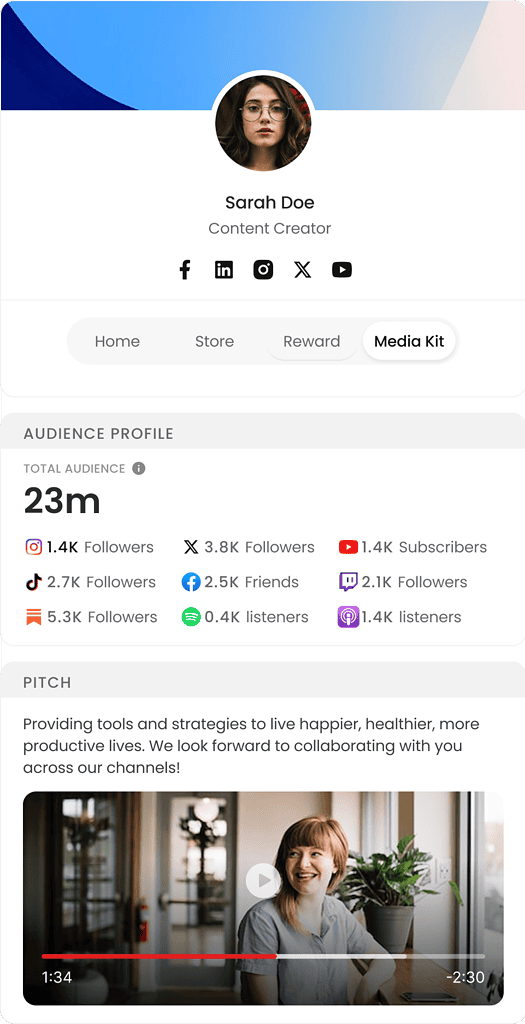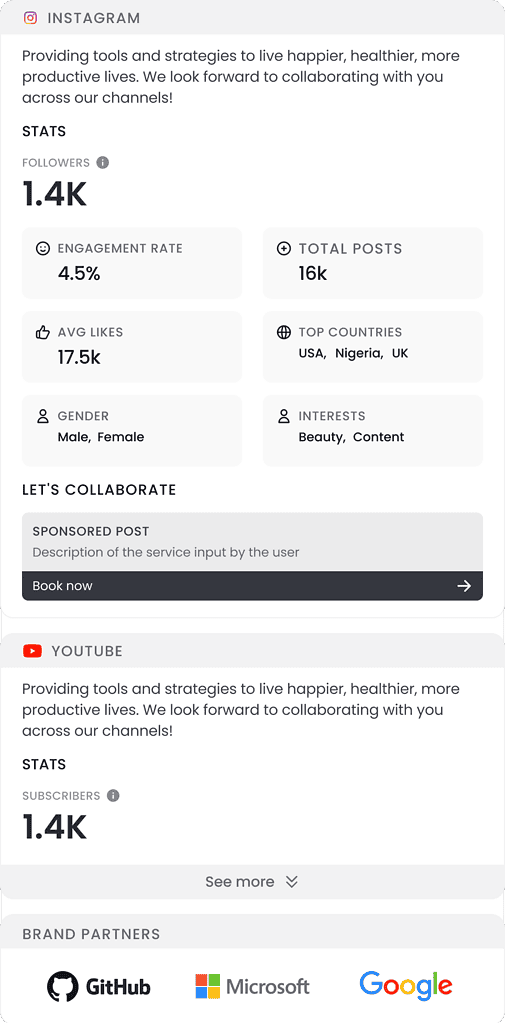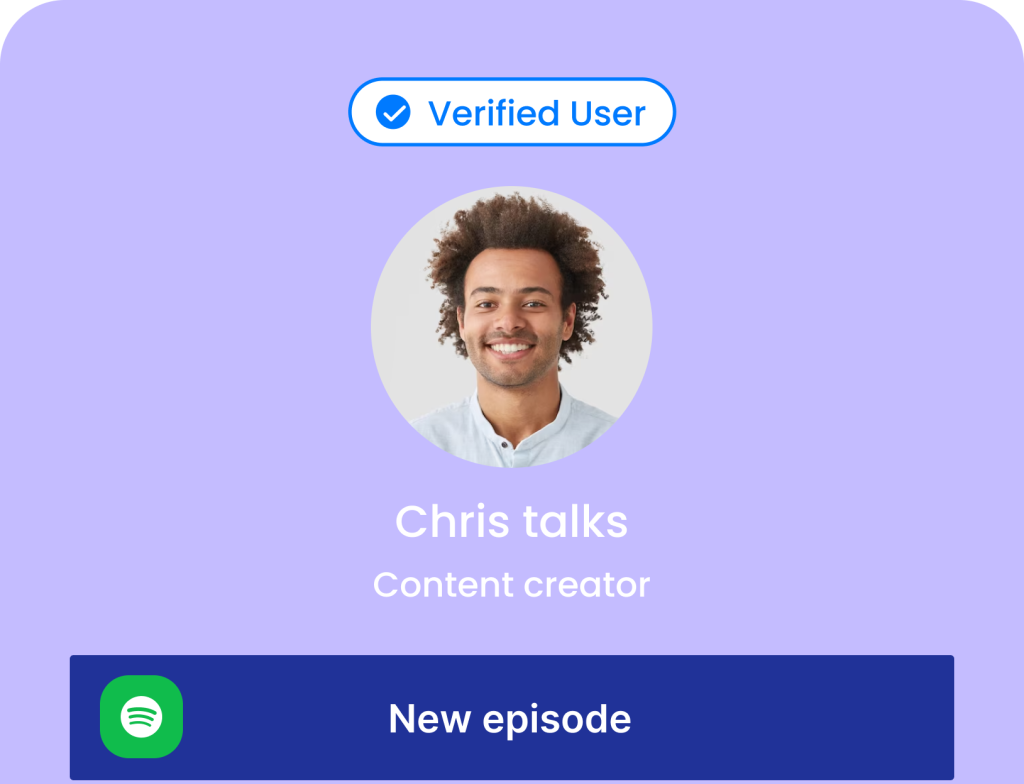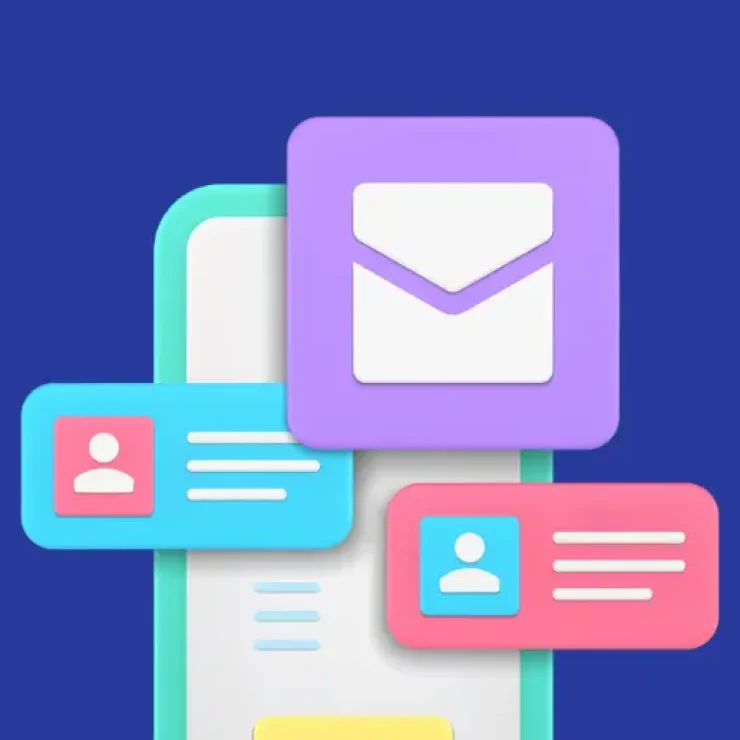If you’re an influencer or content creator looking to land more brand deals, having a professional media kit is a must. It highlights who you are, your audience insights, and why brands should work with you. A well-structured media kit makes you look professional, saves time in negotiations, and increases your chances of securing brand collaborations.
Brands want to know your value before investing in a partnership. With the right influencer toolkit, you can showcase your follower demographics, engagement rates, and past collaborations in a clear and appealing way. However, creating a media kit from scratch can be time-consuming and tedious if you don’t know what to add.
To help out, creators can turn to Pushbio; a creator management tool that offers a media kit feature. With the help of Pushbio, creators can design and share a customized, professional media kit effortlessly. In this guide, we’ll provide you with the perfect media kit template for influencers and creators and show you how Pushbio makes the process seamless.
Why creators need a media kit
A media kit is a document that introduces you as an influencer or content creator to potential brand partners. It serves as a digital portfolio, showcasing your social media presence, audience demographics, engagement rates, and past collaborations. It helps brands quickly understand your value and whether you are a good fit for their marketing campaigns.
Without a media kit, you might miss out on partnership opportunities simply because brands don’t have enough information about you. Having a professional, well-designed media kit offers several advantages including:
1. Make a powerful first impression
First impressions matter, especially when pitching to brands. A media kit template helps you present yourself professionally from the start. Instead of just sending a casual email or DM, a well-structured media kit shows brands that you are serious about collaborations.
It includes your branding, audience insights, and past partnerships, making it easier for companies to see your potential. Brands are more likely to work with influencers who come prepared. A polished media kit not only makes you look professional but also helps you stand out from the crowd.
2. Save time with a ready-to-go portfolio
A media kit template keeps all your important details in one place, so you don’t have to keep repeating yourself to different brands. Instead of answering the same questions about your audience, engagement rates, and content style, you can simply send your media kit.
This influencer toolkit makes communication smoother and more efficient, allowing brands to review your information quickly. It also saves time for you, so you can focus on creating content rather than constantly explaining your value.
3. Boost your credibility
Brands want to work with influencers who take their craft seriously. A well-designed media kit template proves that you are a professional content creator who understands the industry. Having a media kit also signals that you are experienced in brand collaborations and that you know how to deliver results. This credibility can set you apart from others who don’t take the extra step to present themselves professionally.
4. Eliminate back-and-forth conversations
Negotiating with brands can be time-consuming, especially if they have to ask for details like your pricing, audience demographics, or past work. A media kit template eliminates unnecessary back-and-forth by giving brands all the information upfront. Instead of endless emails, they can quickly review your media kit and decide if you’re the right fit. This makes the collaboration process smoother and ensures that you’re only engaging with brands that align with your values and content style.
5. Tell your unique story
Your media kit is more than just numbers, it’s a chance to share your journey as a creator. Brands don’t just want statistics; they want to know your vibe, content style, and how you align with their brand goals. A media kit template lets you highlight your niche, personality, and the unique perspective you bring to the table. Regardless of the niche, your media kit helps brands see how your content fits their marketing strategy.
6. Build trust with brands by showcasing your metrics
Trust is key in any brand collaboration. Brands want to know that their investment in you will bring results. A strong influencer toolkit includes your audience demographics, engagement rates, and past successful collaborations. These numbers give brands confidence that working with you is worth it. The more transparent you are about your performance, the more likely brands are to trust and invest in your content.
7. Attract the right brand partnerships
Not all brand deals are the right fit. A media kit template helps attract brands that align with your values and audience. When you clearly outline your niche, content style, and audience demographics, brands that share similar goals will be more likely to reach out. Instead of accepting random sponsorships, you can secure meaningful brand collaborations that feel authentic to your followers. This leads to stronger, long-term partnerships that benefit both you and the brand.
The perfect media kit template for influencers and creators
A media kit is not repository of all your information. Rather it is a carefully, highly selected collection of important metrics that are of value to a brand seeking partnership with a creator. This is why having the right template to work with is essential as it guides what you add to your kit.
1. Choose the right design tool
The first step in creating a professional media kit template is selecting the right design tool. Choosing a template that fits your style makes the process faster and keeps your media kit looking professional. You don’t need to be a graphic designer to make an impressive media kit and there are plenty of easy-to-use tools like Pushbio, Canva, Adobe Express, or even pre-made templates.
These tools provide customizable designs that help you put together a polished and visually appealing document. Pushbio media kit feature is simple to edit, ensuring that you can update your stats and achievements regularly.
2. Ensure your visual branding stands out
A strong brand collaboration starts with a creator who knows their identity and can communicate it well. Therefore, your media kit should reflect your personal brand, just like your social media content does. This means using your signature colors, fonts, and logo to make your kit visually cohesive.
Brands want to see consistency because it shows that you are serious about your image and content. Your media kit should look clean, modern, and aligned with your overall aesthetic, making it easy for brands to recognize your unique style.
3. Add the right information to show your value
A media kit is your digital resume, so it must contain the right details. Include a short bio, your social media platforms, audience demographics, engagement rates, and previous brand collaborations. Also, add testimonials from past partners if possible.
These details help brands understand your reach, influence, and whether you’re a good fit for their marketing campaign. Keep it concise as brands don’t want to read long paragraphs, but they do need enough information to make a decision.
4. Polish for a professional look
A clean, well-organized media kit template increases your credibility and ensures that brands see you as a reliable and detail-oriented creator. Taking the time to polish your media kit shows that you respect your brand and potential brand collaborations.
So before sending out your media kit, double-check everything. Spelling mistakes, outdated statistics, or messy formatting can make you look unprofessional. Read through the document carefully and make sure your numbers are up-to-date. If possible, ask a fellow creator or mentor to review it.
5. Start sending your media kit to brands and agencies
Once your media kit is ready, it’s time to put it to work. Start by reaching out to brands that align with your niche. You can also connect with influencer agencies or include your media kit link in your email signature. A well-crafted influencer toolkit makes pitching easier because it provides all the necessary information upfront.
How Pushbio makes media kit creation effortless
Pushbio makes creating a media kit simple with its dedicated media kit template feature. Instead of struggling with design software, Pushbio allows influencers and creators to generate a professional, well-structured media kit in just a few clicks.

We provide an easy way to organize and present your key details, making it easier to attract brand collaborations. Creators can enjoy the following when building their media kit:
- Easy customization: No need for graphic design skills. Pushbio offers a simple template that lets you personalize your media kit with your branding, colors, and fonts.
- Seamless sharing: Generate a shareable link so you can send your media kit to brands instantly.
- Built-in analytics: Track who views your media kit to gain valuable insight for refining your pitch.
- Always up-to-date: Unlike static PDFs, Pushbio allows you to update your media kit in real time with its seamless connection to your social media pages for pulling data. This ensures brands always see your latest stats and collaborations.

How to create your media kit on Pushbio in simple steps
With Pushbio, creating and updating your influencer media kit has never been easier. It’s the perfect solution for streamlining your brand partnerships and making a strong impression on potential collaborators.
With Pushbio’s media kit feature, you can showcase your stats, services, and past work in a sleek, professional way. Follow this simple guide to create your own influencer media kit:
Step 1: Create or log into your Pushbio account
- First, log into your Pushbio account. If you don’t have an account, you can create one here.
- From the sidebar menu, go to the “Link in Bio Page” section.
- Create a link in bio page and customize it to fit your brand.
- Alternatively, if you already have multiple pages, choose the one where you want to add your media kit template.
Step 2: Add the media kit block
- Now, scroll down and click on the “Add Block” button.
- A menu will appear with different block options. Find and click on the “Mediakit” tab.
- Once the options load, select “Mediakit” from the list. This will add a dedicated section to your page where you can input all your details.
Step 3: Customize your media kit
Set up the basics
- In the “Block Name” field, enter a title for your media kit (e.g., “My Influencer Media Kit”).
- Next, go to the Platforms section. You’ll see a list of popular social media platforms. Simply toggle on the ones you want to include.
- For each platform you activate, click on the forward-facing arrow to open its settings.
Auto-Update your social stats
- Toggle on “Automatically Update Data” to ensure your media kit stays current with your latest follower counts and engagement metrics.
- Click the “Pull Data” button. This will redirect you to the selected platform, where you can follow the instructions to link your profile.
Step 4: Add your pricing and services (Rate Card)
Brands want to know your rates upfront. Make it easy for them by using this section to add details about your pricing structure.
- Under the “Rate Card” section, click “Add Rate” to input your pricing.
- Enter a title for the service (e.g., “Instagram Sponsored Post” or “YouTube Video Collaboration”).
- If you have a set price, enter it in the “Price” field. Otherwise, leave it blank for negotiation.
- Provide a detailed description of the service, including deliverables and estimated turnaround time.
- Click “Add Rate” and repeat for each service you offer.
Step 5: Craft your pitch and showcase past work
Write an engaging pitch
Under the “Pitch” section, introduce yourself in a way that grabs a brand’s attention. Keep it professional yet personal. Highlight your niche, audience demographics, and why brands should collaborate with you.
Bonus tip: If you have a video pitch, add the link in the “Video Link” space to make your media kit even more compelling.
Show off your previous work
Want to prove your experience? Under “Previous Works,” add links to past campaigns, sponsored posts, or case studies. If you’ve worked on custom projects, fill out the “Custom Work” section with details like project title, contact email, and a brief description of the work done.
Step 6: Design and display settings
Make it visually appealing
Go to the “Design Tab” and customize the look of your media kit:
- Choose a text and background color that matches your brand.
- Adjust text alignment (left, center, right, justify).
- Play around with border styles, shadow effects, and animations to make it stand out.
Control who sees your media kit
Under the “Display Tab,” you can:
- Set a date range for when your media kit will be active.
- Restrict visibility by country, device, browser language, or operating system (or leave it open to all).
Step 7: Save and share your media kit
Once everything looks perfect, click “Add Block” to finalize your media kit template on Pushbio. Now, you can share your link in bio or send it directly to brands when pitching collaborations.
What stats should be included in a media kit?
A well-structured media kit template should provide brands with all the essential data they need to assess your influencer capabilities and potential for brand collaborations. Here are the most important stats to include:
1. Audience size and growth
Brands want to see how large and engaged your following is. Include:
- Total followers/subscribers (Instagram, TikTok, YouTube, Twitter, etc.)
- Growth rate (how quickly your audience is increasing)
- Monthly new followers/subscribers
2. Engagement metrics
Engagement is often more important than follower count. Include:
- Average likes, comments, and shares per post
- Engagement rate (%)
- Story views (if relevant to Instagram, Facebook, or Snapchat)
3. Audience demographics
Brands need to know if your audience matches their target market. Include:
- Age range (e.g., 18-24, 25-34, etc.)
- Gender breakdown
- Location (top countries or cities your audience is from)
- Language preferences
4. Content performance
Highlight the success of your content with these stats:
- Average video views (for YouTube, TikTok, or Reels)
- Highest-performing posts (screenshots or links to viral content)
- Click-through rate (CTR) on links in your bio or posts
5. Website and email analytics (If applicable)
If you have a blog, website, or newsletter, include:
- Monthly website visits
- Page views per session
- Email subscriber count & open rate
6. Past Brand Collaborations & Case Studies
Show proof of successful brand collaborations with:
- Brands you’ve worked with (logos or names)
- Results from past campaigns (e.g., “This campaign generated 50K impressions and 2K link clicks”)
- Screenshots of positive brand feedback or testimonials
Wrapping up
A well-structured media kit template is essential for influencers and creators who want to secure brand collaborations and grow their careers. It helps you present your stats, showcase your past work, and make a strong first impression on potential partners. Having a professional influencer toolkit also saves time, builds credibility, and attracts brands that align with your audience and values.
Creating a media kit doesn’t have to be complicated. With Pushbio’s media kit feature, you can design, customize, and share your media kit effortlessly. Whether you’re a new influencer or a seasoned creator, Pushbio makes it easy to stand out and land more opportunities.








